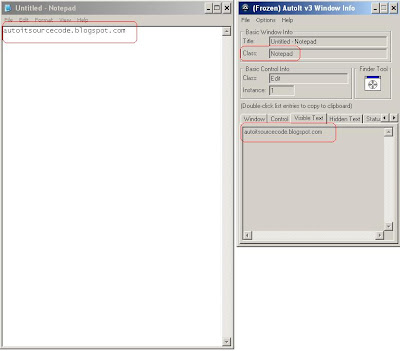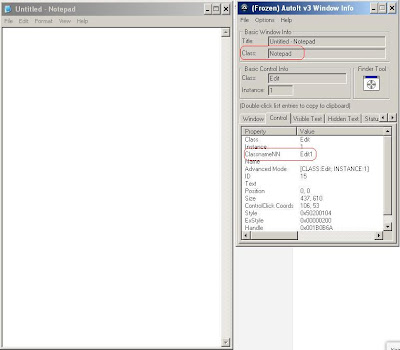Simple Notepad Automation Using Autoit C#
This is a simple example of how to work with Notepad for sending text, copy / paste, and save it as a file. I will try to explain as details so that you can easily understand.You can adding this code into your project. This is additional function that I have made, you can copy and paste.
private void Type(string strKeys, int nMode, string strControl, bool blnSleepKeys, int nSleep, string strWindow)
{
if (blnSleepKeys)
{
char[] achKeys = strKeys.ToCharArray();
foreach (char ch in achKeys)
{
autoit.ControlSend(strWindow, "", strControl, ch.ToString(), nMode);
Thread.Sleep(100);
Trace.WriteLine("Sent Key: '" + ch.ToString() + "'");
}
}
else
{
autoit.ControlSend(strWindow, "", strControl, strKeys, nMode);
Trace.WriteLine("Sent Keys: " + strKeys);
}
for (int i = 0; i < (nSleep / 100); i++)
{
Application.DoEvents();
Thread.Sleep(100);
}
}
private void Click(string strButton, int nNumClicks, int nX, int nY, string strControl, int nSleep, string strWindow)
{
autoit.ControlClick(strWindow, "", strControl, strButton, nNumClicks, nX, nY);
for (int i = 0; i < (nSleep / 100); i++)
{
Application.DoEvents();
Thread.Sleep(100);
}
}
The first step that must be done is to determine the required parameters like as title, text, control, etc..
You can see the images below.
Parameters :
Title : "[CLASS:Notepad]" or "Untitled - Notepad"
Text : ""
Control : Edit1
nX : 78
nY : 53
private void runButton_Click(object sender, EventArgs e)
{
//check if notepad is already exist
if (autoit.WinExists("[CLASS:Notepad]", "") == 1)
{
//notepad closed
autoit.WinKill("[CLASS:Notepad]", "");
}
//execute notepad.exe
autoit.Run("Notepad.exe", "", 1);
//wait for max 25 seconds
autoit.WinWaitActive("[CLASS:Notepad]", "", 25);
//check if notepad doesn't exist
if (autoit.WinExists("[CLASS:Notepad]", "") == 0)
{
MessageBox.Show("Notepad didn't opened");
}
else
{
//activate the notepad
//or set notepad into front
autoit.WinActivate("[CLASS:Notepad]", "");
}
//send some text into text area
string strText = "autoitsourcecode.blogspot.com";
Type(strText, 0, "Edit1", true, 500, "[CLASS:Notepad]");
//try to copy / paste
//send CTRL+ a
Type("^a", 0, "Edit1", true, 1000, "[CLASS:Notepad]");
//send CTRL + c (Copy)
Type("^c", 0, "Edit1", true, 1000, "[CLASS:Notepad]");
//send CTRL + v (paste)
Type("^v", 0, "Edit1", true, 1000, "[CLASS:Notepad]");
//send CTRL + v (paste)
Type("^v", 0, "Edit1", true, 1000, "[CLASS:Notepad]");
//send CTRL + v (paste)
Type("^v", 0, "Edit1", true, 1000, "[CLASS:Notepad]");
//send CTRL + v (paste)
Type("^v", 0, "Edit1", true, 1000, "[CLASS:Notepad]");
//save the file
//send key alt + f + a
Type("!fa", 0, "Edit1", true, 500, "[CLASS:Notepad]");
//wait the "save as" win dialog is opened until 25 seconds
autoit.WinWaitActive("Save As", "", 25);
//check if didn't open
if (autoit.WinExists("Save As", "") == 0)
{
MessageBox.Show("The can't saved");
}
This is images Save As window info
Parameters :
Title : "Save As"
Text : ""
Control : Edit1
nX : 109
nY : 8
//send key directory folder
Type(@"C:\autoitDemo.txt", 0, "Edit1", true, 1000, "Save As");
//check the files
if (File.Exists(@"C:\autoitDemo.txt"))
File.Delete(@"C:\autoitDemo.txt"); The image for click Save button
Parameters :
Title : "Save As"
Text : ""
Control : Edit1
nX : 46
nY :13
//click button save
Click("left", 1, 42, 15, "Button1", 1000, "Save As");
//check if notepad is already exist
if (autoit.WinExists("[CLASS:Notepad]", "") == 1)
{
//notepad closed
autoit.WinKill("[CLASS:Notepad]", "");
}
}
Download Full Source Code




























